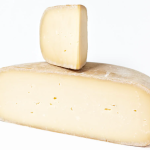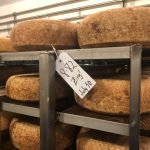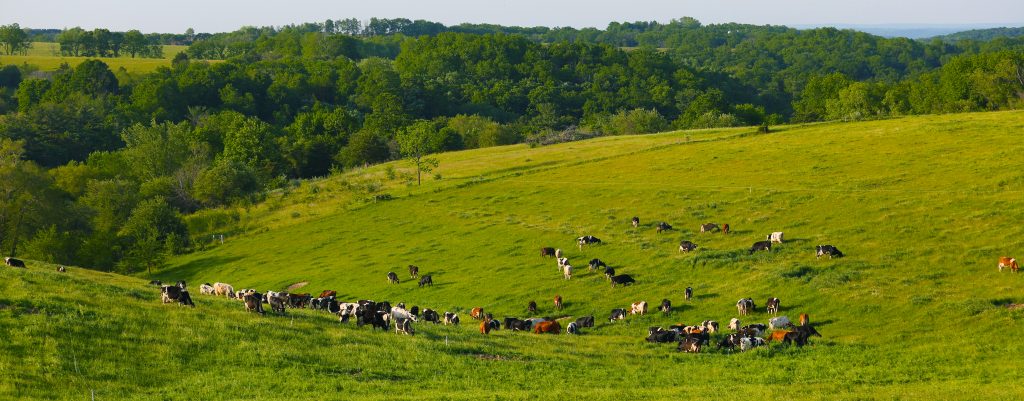
Herd About Uplands Cheese?
Uplands Cheese’s dairy farm sits on Pleasant Ridge, in the Driftless Area of southwest Wisconsin. (If you’re already familiar with them, yes, their signature cheese is named after the landform they’re located on!) The region earned its name due to it being the one corner of the state that wasn’t scraped flat by receding glaciers; since it doesn’t have any glacial deposits, otherwise known as drift, it is… drift-less. Instead, its rolling ridges and swales were formed by rivers and streams, with soils ideal for raising grazing animals thanks to the variety of grasses, legumes, and wildflowers that grow well in these soils. The area has a rich history of small dairy farms—cows have been raised and milked on their land for over 100 years!—and Uplands Cheese’s owners, Andy and Caitlin Hatch and Scott and Liana Mericka are helping to ensure the continuation of that history.
In 1994, founders Mike Gingrich and Dan Patenaude bought this farm to combine their small herds and manage them using a seasonal, pasture-based system. Andy and Scott began as apprentices under Mike and Dan, then transitioned to managers, and eventually owners. In 2014, the Hatches and Merickas purchased the farm from the Gingriches and Patenaudes—Scott took over Dan’s role with the cows and Andy took over for Mike in the creamery.
Deli Specialty Foods Manager Trevor Murray actually went and worked at Uplands for four seasons! He appreciated experiencing firsthand the benefits of Andy and Scott’s partnership, saying:
Andy’s skill is in developing and fine-tuning the recipe and managing the creamery’s logistics; Scott provides the raw material that makes that possible. There’s a lot of mutual admiration between the two—Scott’s dream of farming and working close to the land wouldn’t be feasible without the value-added production, or what Scott and Andy call a “cheese plan.”
Udder-ly Unique Cows
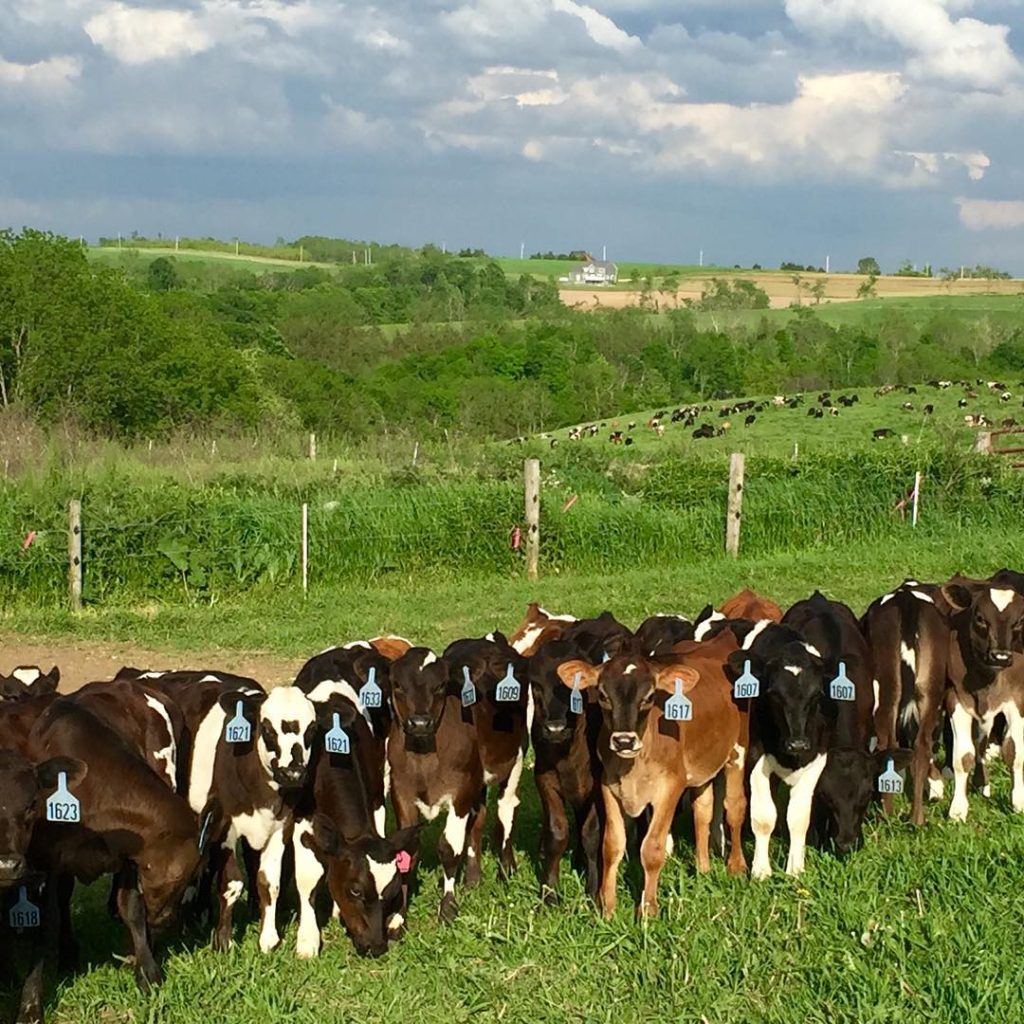
That cheese plan starts a long time before any milk actually gets turned into a batch of cheese. It really begins with their herd of customized cows (okay, not really, but kind of!). They’ve cross-bred nine different types of cows in an effort to breed cows that thrive on their farm. As Andy explains,
Some of the first things we look for in a cow are her physical characteristics. Because a cow on our farm spends her life outside grazing pasture, she needs to be athletic and robust. This often isn’t the case with modern cows, who are bred with the assumption that they’ll live a sedentary life in a barn. As the modern Holstein is becoming ever larger, we breed less for size than for mobility and efficiency in converting grass into milk.
Another focus of their breeding is being able to supply their creamery with the ideal milk for making their cheese. Each breed produces milk that’s unique—in terms of composition, or amounts and types of fats, proteins, minerals, and vitamins—and all milks aren’t equally suited to all types of cheese. Andy says they’re looking for a particular balance of the major components of their milk (in terms of fat and protein) as well as flavor complexity, adding:
…the flavor of grass-fed milk is a fact often lost among modernity’s emphasis on volume and efficiency, but certain cheese makers in both the new and old worlds still recognize this. The milk from our crossbred herd inherently contains a more diverse range of sizes and types of fats, proteins, vitamins, and minerals. As our cheeses age, this diversity enables a wider range of interactions among the microflora in the cheese and on the rind, which in turn generate a more complex array of flavors. Complexity breeds complexity.
So, by selectively crossbreeding their cows, their herd is continually evolving, improving with each successive generation to become better suited to their farmland, as well as to have more of the characteristics in the milk that they’re looking for.
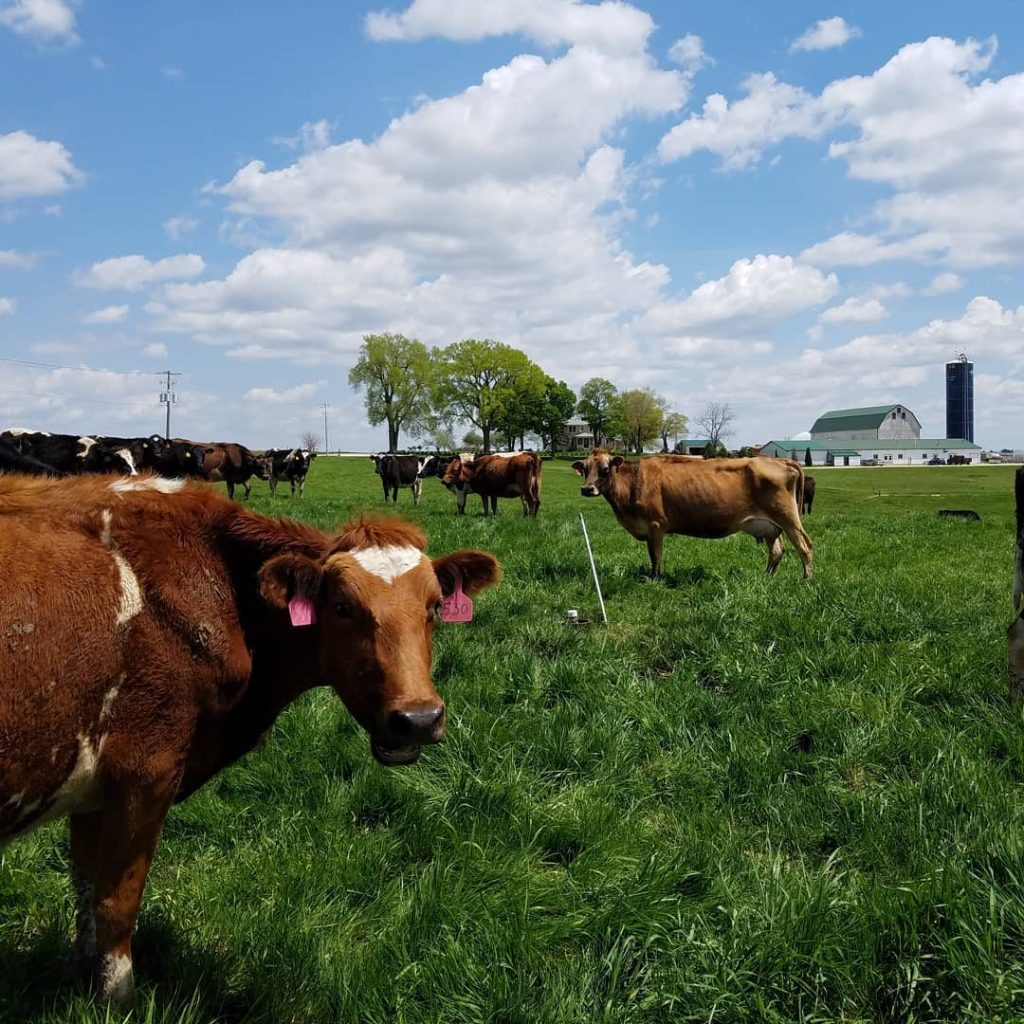
Out-standing in Their Field(s)
Unlike most modern dairy farms that keep cows in barns year-round and milk them all year long, their herd of 200 cows is pasture-raised and milked seasonally. It’s a method in-line with an older, traditional style of dairy farming: Cows have their calves in the spring right as the grasses start growing; the cows are milked throughout the spring, summer, and fall; and then the cows are given a few months vacation (or, in farmer lingo, they’re allowed to “dry off”).
Their farm spans around 400 acres of pasture, all segregated into smaller enclosures, called paddocks. Throughout the milking season, the cows are moved to a different five-acre paddock after each milking session—it takes them about a month to rotate through them all, giving the grass time to regrow. Andy talks about the importance of the timing of that rotation, saying:
…you try to put the cows into a field right before all those plants are going to seed. That’s the maximum richness, nutrition content, flavor, is in the grass right before it’s going to seed. It’s pumping all of its energy up into its leaves, but you want to pull the cows out again before they eat it down too short and stunt the regrowth, so it’s a balancing act between managing the cows in your nutrition and flavor and the health of the soil and plants.
Rotational grazing benefits the cows, the land, the farmers, and us, the consumers! The cows always get fresh grass, along with lots of fresh air and exercise. The land never gets overgrazed, allowing it time to re-grow for the next grazing cycle. Plus, since they’re getting nibbled, not plowed, the farm’s steep hillsides suffer from less erosion. The farmer gets happy healthy animals and doesn’t have to spend all day feeding the cows and cleaning a barn. And, since grass-fed milk is so flavorful, we get better tasting cheese.
Better tasting cheese does not mean consistent, homogenous batches. On the contrary, no two batches of their cheeses will taste exactly the same. That’s exactly what they’re going for and that’s actually thanks to the pasture. As Andy says of their cows and their cheese:
They’re getting a fresh pasture every 12 hours after every milking, and each 12-hour grazing session they’ll graze about five acres depending on the time of year, so really what we’re tasting here and feeling in our mouths is a different ten acres of our farm every batch. That’s the variable at play here. It’s the same cows, the same cheese maker, the same recipe, day after day after day, but a different ten acres every time. And that is really terroir, what this cheese tries to highlight and what you’re getting a peek into now, is the influence of terroir on a product like this, how does it cause it to change batch to batch because the cows are on different pasture.
Legen-dairy Cheeses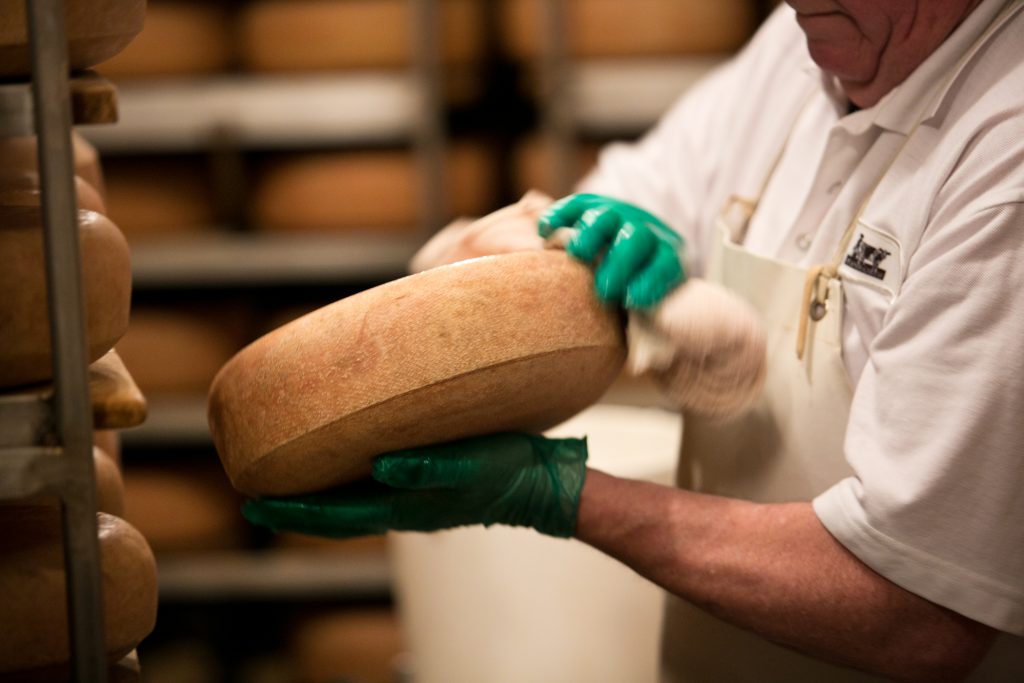
Uplands Cheese is capturing the flavors of their pasture within the milk by turning it into cheese. By borrowing the old-world concept of turning summer grass-fed milk into an aged cheese made in the tradition of Alpine cheeses like Gruyere and Beaufort, they’re able to preserve their seasonal bounty of delicious, raw, grass-fed milk and have a year-round income that doesn’t require milking cows year-round. That’s exactly what they’ve been doing for over 20 years now with their Pleasant Ridge Reserve! They also make a second cheese in the fall when the cows start eating hay. Rush Creek Reserve is a small, soft cheese, that’s only sold in November and December.
Pleasant Ridge Reserve
Pleasant Ridge Reserve is cheesemaker Andy Hatch’s keystone queso, America’s premier alpine style, and the holder of our hearts. (Did we mention that this aged, raw cow’s milk cheese won more awards than any other cheese in American history?!) It’s a staple of almost every cheese board made at the Deli and now, maybe of every one you make, too?!
Here at the Deli, not only do we get dibs on our own batches—they’re exclusive to us and impossible to find anywhere else—but we also do the batch tasting as a public event each spring. Together we can all taste the various batches that have been set aside for Zingerman’s and find out which batch our mongers chose and why. Our current batch is tasting fine: smooth, creamy, and full of big fruity notes you’d expect from a French Beaufort. Read more about it here.
Rush Creek Reserve
This full-flavored, pudding-like raw cow’s milk cheese is made in the style of Vacherin Mont d’Or. As Andy explains, “As the milk comes into the autumn months, fat goes up, protein goes up, and it gets to be a bit rich for a hard cheese, but it’s perfect for a soft cheese.” It’s made only in the weeks between September and November, then aged for another eight weeks, and is available exclusively in November and December. Just trim off the top rind and dig right in! Read more about it here.

